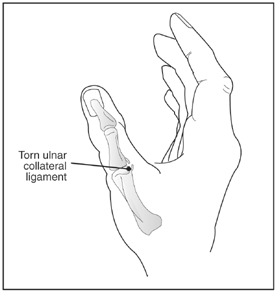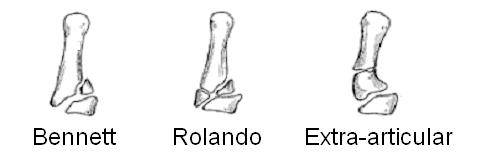Thumb Joint Pain Causes
Thumb joint pain is a highly discomforting and distressing symptom. It leaves a person perplexed, when it comes to performing even trivial daily activities, like brushing, writing, and so on. Several unsaid human gestures utilize the thumb, in good proportion, to ask for a free ride (hitchhiking), express dissent (thumbs down) or give a simple reassurance (thumbs up) to someone. Thus, apart from its help in gripping objects, the thumb is an important part of our social life too. Hence, thumb pain or inability to use the thumb greatly loosens the grip on our daily routine.
Due to the short length of the thumb and an innate human reflex to protect it, there are relatively few situations, where the thumb is actually injured. Thumb joint pain can be due to traumatic as well as degenerative causes. Sports injuries are a special type of thumb injuries, and can be due to an acute cause or repetitive use over a prolonged period. These injuries not only affect the career profile of a player, but can sometimes force a player to take premature retirement from the game as well. Hence, thumb injuries, or rather any type of thumb joint pain, should not be taken lightly.
Traumatic Causes of Thumb Joint Pain
Traumatic causes of thumb joint pain can be separated into fractures, dislocations, and ligament injuries. Generally, these are due to a sudden forceful movement of the thumb and are associated with severe thumb joint pain and swelling of the entire hand and wrist. Even a slight touch or movement of the thumb in any direction elicits thumb pain.
Thumb Fractures are commonly located near the base of the thumb, which is the part that remains exposed as the remaining portion of a thumb is enclosed in the fist. A common sign of a thumb fracture is the presence of a clicking sensation in the thumb, which remains positive even in untreated old fractures of the thumb. This clicking is generally due to an intra-articular (inside a joint) fracture, because of partial or complete dislocation of the carpo-metacarpal (CMC) joint at the base of the thumb. There are three types of thumb fractures, namely,
- Bennett Fracture – is an intra-articular fracture at the base of the thumb (Picture 1), which is caused by a fall on the thumb or from thumb injury after punching a hard object. It causes severe thumb joint pain, instability, and swelling.
- Rolando Fracture – is also an intra-articular fracture, but is more severe than a Bennett fracture, because it is comminuted (consists of several small pieces) (Picture 1). It is a rare thumb injury, but nearly always requires surgical treatment. Thumb joint pain may persist for months after this injury, due to premature thumb arthritis, even after surgical treatment.
- Extra-articular Fracture – is a simple fracture of the shaft of the phalanges (small bones present in thumb and also in fingers) (Picture 1). They do not cause severe symptoms, are less common, and respond well to non-surgical treatment options.
Picture 1: Types of thumb fractures
(Source: Healthhype)
Thumb ligament injury is a common sports injury, and is also known by the names, “gamekeeper’s thumb” or “skier’s thumb”. The thumb ligament that is torn in this injury is called the “ulnar collateral ligament (UCL) of thumb” (Picture 2). A fall on the thumb, which stretches the thumb sideways, is responsible for a UCL injury.
 Picture 2: Thumb ligament injury
Picture 2: Thumb ligament injury
(Source: NIAMS)
Thumb joint pain, swelling, instability and severe bruising at the base of the thumb are some characteristic signs of a thumb ligament injury, which are mainly due to rupture of blood vessels along with the ligament. Untreated or neglected injuries can even progress to a compartment syndrome, which necessitates amputation of the entire hand. Hence, appropriate medical care should be sought as early as possible !
Thumb dislocation can occur either with or without a thumb ligament injury. When it occurs along with a fracture, it is called a fracture-dislocation of the thumb. The thumb has a carpo-metacarpal joint (CMC) joint at the base of the thumb and an inter-phalangeal joint between the phalanges. Dislocation can occur at either of the joints, but is more common at the CMC joint at the base of the thumb, due to the innate reflexive response discussed above.
An isolated dislocation of the thumb generally leads to restricted thumb movements, rather than the thumb joint instability, that occurs in other injuries of the thumb. Thumb joint pain is felt typically on attempting to move the thumb, and there is considerably less swelling, because the joint capsule of the thumb, which is the actual site of injury, is less vascular and also less sensitive to pain.
Thumb Joint Pain from Modern Technology
With changing lifestyle and technology, several new gadgets are being introduced, which cause thumb injury in a subtle manner. The most popular gadget in this regard, is a QWERTY keypad cellphone, which is very common among teenagers. The repetitive action of the thumb involved in typing messages or “texting” on such phones, causes soft tissue injury of the thumb, ultimately leading to thumb joint pain and swelling. This type of affection is commonly referred to as “blackberry thumb” or “repetitive stress injury (RSI) of thumb”. The addictive fad of text messaging among teenagers and their ignorance towards its ill effects frequently takes a toll of their thumbs at a tender age.
Apart from cellphones, the very keyboard, which we use for typing on our computer is no way inferior in insulting the thumb, and cause thumb joint pain similar to that seen in De Quervain’s tenosynovitis. This is especially applicable for those, who have learned typing or who type for professional needs, by using both hands simultaneously and not for an amateur typist, who types one letter after the other. Frequent use of the computer keyboard is more commonly associated with carpal tunnel syndrome, which occurs on both hands simultaneously. But, thumb joint pain from keyboard use occurs on a single side only, precisely in the thumb which presses on the “space” key (Picture 4), which is the most frequently used key on the entire keyboard.
Picture 4: Keyboard thumb injury
(Source: Wikimedia Commons)
These subtle thumb injuries may not even be noticed by a person until it causes severe thumb joint pain. Many times a person may not even realize the reason behind their thumb pain and continue to perform the incriminated activity, i.e. typing or texting. This not only causes additional damage to the soft tissues of the thumb, but also prevents recovery from the discomforting thumb joint pain. Though, analgesics and anti-inflammatory medications offer temporary relief, pain pill addiction can also have some serious side-effects. Hence, many affected people continue to work until their tolerance is exhausted, seeking alternatives to their typing activity or even their profession as a whole.
Thus, a seemingly simple condition of thumb joint pain, which could have been easily solved with rest and physical therapy for a couple weeks, becomes a life long morbidity and a cause of professional helplessness.
Related Articles:
Thumb Joint Pain Treatment






